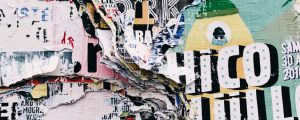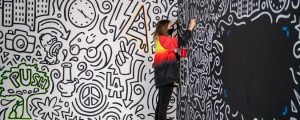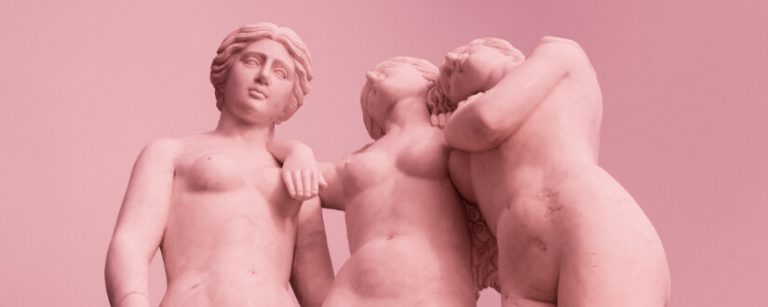Discovering your art style can play an important role in developing your work and artistic practice. From getting inspired to experimenting with new mediums and themes, this guide aims to provide the necessary tools and tips to help you find which style best aligns with your identity as an artist.
What is an art style?

The Collins Dictionary explains, “In the arts, a particular style is characteristic of a particular period or group of people.” There are a wide range of styles and therefore ample possibilities when it comes to defining your own. There are some movements that you might be more readily aware of such as Romanticism or Dadaism and others that sound less familiar like Outsider Art or Vorticism. Artistic styles are varied in their nature and can represent differing advances, sentiments and moments in history.
Get inspired

Find room to reflect on different ideas, themes, subjects, mediums, spaces and even time periods that energise you and more importantly – make you want to start creating.
When seeking inspiration, it can be useful to entertain jealousy as an unexpected force for good. Harnessing jealousy and inner criticism as a source of inspiration, drove Danielle Krysa to create her famous blog, The Jealous Curator. There she talks about her process by explaining, “I started the blog to document the work I loved, but more importantly, I wanted to find a way to flip the jealousy into something positive – admiration and inspiration to be specific.”
In a similar vein, visual artist Brandon Breaux talks about staying positive and inspired in an interview with The Creative Independent, “I’m finding inspiration…wherever I am in the world or have to be at the time, so I can use it to fuel my practice and fuel my creative work.”
Removing boundaries from what may have previously been classified as a legitimate source of inspiration, allows for a more expansive playing field. Meditating on inspiration used in past work and ideas for future pieces, is an effective way to start drawing parallels and finding recurring themes in your process. Uncovering what is meaningful to you as an artist, will aid in the process of finding your style.
Start experimenting

Now bring some of this research together and try new things. Commit yourself to experimentation, and avoid any kind of judgement, at least in the early days. Try employing the philosophy behind free writing in your experimentation process, create whatever comes to the surface without editing it or correcting it.
Tapping into your subconscious will allow for a purer experimental experience. In his book, Playing to the Gallery, Grayson Perry says, “The artists of the past were locked into their time in history. Now we are in a time of post–historical art, anything can be art but not everything is art. In an age without boundaries I am more fascinated than ever by their possibilities.”
In Hans Ulrich Obrist’s book, Ai Weiwei Speaks: With Hans Ulrich Obrist, the artist talks about a similar sentiment, stating: “If you have plans, you only have one go. If you don’t have plans, it often turns out well because you’ve followed the situation. That’s why I’ve always jumped into unprepared situations, the most exciting conditions.”
Experiment with mediums as well as emotional responses. What are these trials evoking on a deeper level? Take notes on the results of these experiments. What continues to be brought to the surface? Does your work convey a strong sense of longing? A social call to action? A particular feeling? Enjoy the freedom that trying new approaches can bring and make sure to document these findings.
Discover other artists

Research, engage and push yourself to collaborate with other artists. Let your interests take you down a research rabbit hole, leading you to discover more art and artists that inspire you. Try to do this in real life as well as online. Find workshops, classes, lectures and shows in your local area. Connect with artists online through webinars, social media, podcasts and websites.
Doing this will help you to build a community of artists that will prove invaluable in your creative process. Communicate with these groups of people by not only sharing your work but your ideas and concerns too. Understanding how other artists found their style will most likely aid you in finding yours.
In the Parisian Centre Pompidou’s Henri Matisse exhibition Like a novel (2021), the artist was quoted saying, “The importance of an artist is measured by the quantity of new signs he introduces to the plastic language.” Finding and learning from artists, allows you to understand what signs or tools they have brought into the world – as well as what makes them unique.
Allowing space in your daily, weekly or monthly routine to interact with other artists can prove to be exponentially advantageous when it comes to growing your knowledge, references and creative practice.
Share your work

Now that you have worked hard to get a clearer idea of what themes, ideas and motifs continue to rise to the surface – gauge what an external audience sees. Sharing your work might feel daunting, especially if you haven’t already done this before, but the possibilities of how you go about doing this are truly endless. With helpful tips for living creatively and sharing your work, podcasts like Beyond the Studio – A Podcast for Artists or The Thriving Artist Podcast are a great place to get started.
Find the right space for you, it might be virtual or physical. Make sure to share your work in a setting where you can get feedback not only from people you know and trust, but also new faces who will most likely interpret your work from a different angle.
Stay open to feedback but also strive to preserve your essence by asking targeted questions that centre the conversation on specific concerns, rather than opening the door to open-ended and potentially subjective discussions concerning your work.
Reflect and continue
Learning, seeking inspiration, experimenting, researching and collaborating with artists are all effective methods to better establish your artistic style. Consolidate your identity as an artist but let your work breathe and speak for itself.
Remember, as an artist you will evolve and your style most likely will too. Refer back to this guide whenever you are needing some direction in understanding what styles you are operating under or even creating – striking a balance that works for you.








